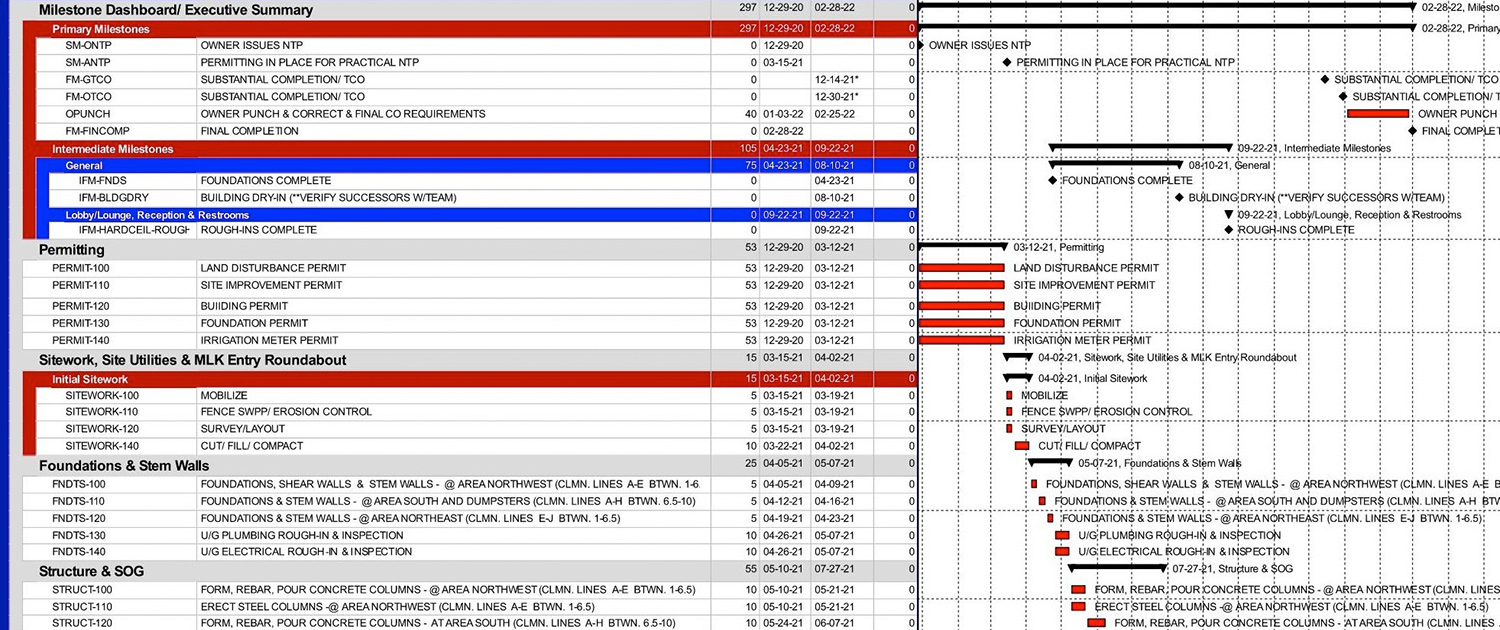The Right Tool for The Right Job: Schedule in CPM Tools
While it’s redundant to the majority of project management professionals that CPM scheduling requires schedule maintenance in CPM tools, we frequently benefit service inquiries from clients previously served by select scheduling firms who claim their schedule maintenance in graphical tools constitutes CPM scheduling. If you’re one of these entities deliberating a course correction consider the following. Put plainly, CPM schedules require a calculated schedule reflect the criticality of each task with its corresponding total float or slack value so the contractor’s project management team can address the project’s completion paths in order of their criticality; primary, secondary, tertiary…etc. This simply isn’t possible after a graphical scheduler has manually statused tasks in a graphical eight-week Near Term Schedule.
Following status completion at the subcontractor meeting, ask a graphical scheduler to quantify the project’s exact delay to completion and their best answer will be a reluctant approximation. That’s because to ascertain the exact project delay the graphical scheduler would need to separately migrate the status obtained at the subcontractor meeting in the Near Term Schedule’s into their separately maintained Overall Project Schedule (OPS) that comprises all the project’s tasks. But the criticality of the project’s status requires exact quantification immediately following obtained commitments at the subcontractor meeting for prompt mitigation and pull planning; not later when the graphical scheduler has completed their status migration from their Near-Term schedule into their OPS schedule. As graphical tools lack CPM capability, their outputs don’t publish a float/slack value next to the task’s description because they can’t. That’s why they’re not accepted as legitimate CPM instruments by CPM schedulers and by construction managers acting as owners’ representatives. While we leverage the power of graphical tools for project planning we only utilize CPM scheduling tools such as Primavera P6, Phoenix Project Manager and Microsoft Project for scheduling.
Beyond essential CPM calculation, scheduling tools offer a host of advantages over graphical tools for routine schedule maintenance. Spectrum’s schedules feature an expansive milestone dashboard on the schedule’s first pages comprising sections for the project’s primary and intermediary phased milestones and furnishing the project team and stakeholders with an executive summary reference to benchmark current status against contractual commitments. By contrast, graphical tools require stakeholders to span the project’s entire Time Scaled Logic Network (TSLN) calendar from left to right to discern variance between select incorporated milestones. CPM tools also furnish stakeholders a clear reference to tasks and milestones baseline dates in the schedule’s engineered columns and Gantt chart whereas routine graphical schedule maintenance rarely incorporates baseline milestones and dates on typical outputs.
Coding is another prominent difference between CPM scheduling tools and graphical tools. Spectrum routinely codes same trade tasks and/or grouped trades such as MEPF to produce focused subcontractor reports for increased trade coordination while filtering out unrelated downstream tasks. Spectrum furnishes subcontractors with concise and easy to follow look-ahead schedules to maximize subcontractors’ engagement. Another important utility rendered by CPM coding is the separately programmable finish targets between the GC’s more aggressive completion milestone for subcontractor’s reference and the contractual finish milestone for owner’s reference – where the variance between the two is the contractor’s padding or built-in risk. These milestones coexist in the same CPM schedule but are filtered on reports for their intended recipient so that subcontractor reports feature the GC’s early target and owners reports feature contractual targets. Unlike CPM tools, Graphical tools require two distinct separate schedules for maintenance which is both cumbersome and costly.
Procurement management in CPM tools is also frequently more robust than as depicted in graphical schedules’ designated “key materials” section often limited to major MEPF components, elevators and a select finishes. Due to this limitation, graphical firms resort to a separate Microsoft Excel matrix in which more robust procurement is manually revised each time the schedule is updated. By contrast, tracking a robust procurement effort in a CPM schedule yields quick and simple control over procurement management.
CPM tools are superior to graphical tools for schedule management and provide superior utility for better project outcomes. See our Pull Planning page, where we require CPM tools to execute true Pull Planning initiatives.
How can we help your
project’s success?
Click the button to the right or give us a call
to find out how we can be of service.



